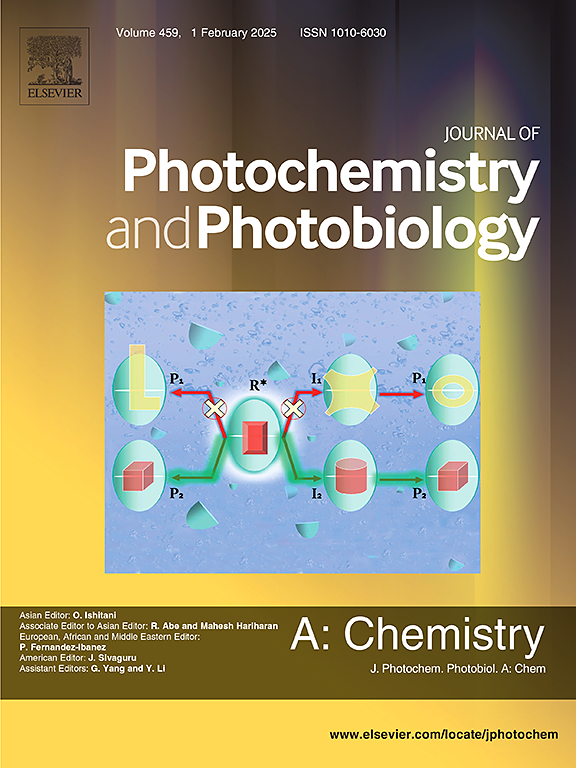Reactive oxygen species mediated-degradation of antiglaucoma drugs. An approach to oxidative stress conditions
IF 4.1
3区 化学
Q2 CHEMISTRY, PHYSICAL
Journal of Photochemistry and Photobiology A-chemistry
Pub Date : 2025-04-03
DOI:10.1016/j.jphotochem.2025.116428
引用次数: 0
Abstract
Reactive oxygen species (ROS) are generated as by-products of oxygen metabolism and play multiple roles in biological systems. In addition, these species can be generated in the eye as a result of the photosensitizing action of pigments that are naturally present in this organ, such as riboflavin. An imbalance between the production of ROS and the response of the antioxidant defense system results in oxidative stress.
In humans, the oxidative stress can lead to the initiation or development of many ocular diseases and injuries (glaucoma, cataracts, macular degeneration). In this highly oxidative cellular environment, topically administered drugs for the treatment of various pathologies may be susceptible to be attacked by ROS and consequently degraded, losing their clinical efficacy or generating toxic products.
In this contribution, the kinetics of ROS-mediated degradation of the antiglaucoma drugs, acetazolamide and methazolamide, was investigated. In order to analyze the effects that these drugs and their derivatives produce on the viability of normal human cells, this parameter was evaluated in the MRC-5 line.
Results showed that acetazolamide and methazolamide interact with the electronic triplet state of riboflavin and with different photo-generated ROS from this state. Both drugs were chemically degraded by singlet oxygen, although methazolamide was more reactive than acetazolamide. The experiments demonstrated that neither the drugs nor their ROS-mediated oxidation products exhibited cytotoxicity in the MRC-5 cell line.
On the other hand, under direct UV irradiation, AZ and MZ generated O2(1Δg) with considerable efficiency compared to other ophthalmic drugs and would be considered good sensitizers.

活性氧介导抗青光眼药物的降解。氧化应激条件的一种方法
活性氧(Reactive oxygen species, ROS)是氧代谢的副产物,在生物系统中发挥着多种作用。此外,由于眼睛中天然存在的色素(如核黄素)的光敏作用,这些物种可以在眼睛中产生。ROS的产生和抗氧化防御系统的反应之间的不平衡导致氧化应激。在人类中,氧化应激可导致许多眼部疾病和损伤(青光眼、白内障、黄斑变性)的发生或发展。在这种高度氧化的细胞环境中,局部给药治疗各种病理的药物可能容易受到ROS的攻击,从而降解,失去临床疗效或产生有毒产物。在这篇文章中,研究了抗青光眼药物乙酰唑胺和甲基唑胺的ros介导降解动力学。为了分析这些药物及其衍生物对正常人类细胞活力的影响,我们在MRC-5细胞系中对该参数进行了评估。结果表明,乙酰唑胺和甲基唑胺与核黄素的电子三重态相互作用,并与该电子三重态产生的不同ROS相互作用。两种药物均被单线态氧化学降解,但甲唑胺比乙酰唑胺反应性更强。实验表明,药物及其ros介导的氧化产物在MRC-5细胞系中均未表现出细胞毒性。另一方面,与其他眼科药物相比,AZ和MZ在紫外线直接照射下产生O2(1Δg)的效率相当高,可以被认为是良好的增敏剂。
本文章由计算机程序翻译,如有差异,请以英文原文为准。
求助全文
约1分钟内获得全文
求助全文
来源期刊
CiteScore
7.90
自引率
7.00%
发文量
580
审稿时长
48 days
期刊介绍:
JPPA publishes the results of fundamental studies on all aspects of chemical phenomena induced by interactions between light and molecules/matter of all kinds.
All systems capable of being described at the molecular or integrated multimolecular level are appropriate for the journal. This includes all molecular chemical species as well as biomolecular, supramolecular, polymer and other macromolecular systems, as well as solid state photochemistry. In addition, the journal publishes studies of semiconductor and other photoactive organic and inorganic materials, photocatalysis (organic, inorganic, supramolecular and superconductor).
The scope includes condensed and gas phase photochemistry, as well as synchrotron radiation chemistry. A broad range of processes and techniques in photochemistry are covered such as light induced energy, electron and proton transfer; nonlinear photochemical behavior; mechanistic investigation of photochemical reactions and identification of the products of photochemical reactions; quantum yield determinations and measurements of rate constants for primary and secondary photochemical processes; steady-state and time-resolved emission, ultrafast spectroscopic methods, single molecule spectroscopy, time resolved X-ray diffraction, luminescence microscopy, and scattering spectroscopy applied to photochemistry. Papers in emerging and applied areas such as luminescent sensors, electroluminescence, solar energy conversion, atmospheric photochemistry, environmental remediation, and related photocatalytic chemistry are also welcome.

 求助内容:
求助内容: 应助结果提醒方式:
应助结果提醒方式:


